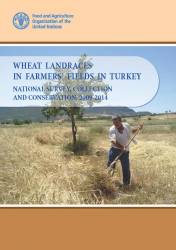 Turkey is located at a unique position from the view point of plant genetic diversity. Due to its great variety in geomorphology, topography, and climate, Turkey has a large diversity of habitats so it is very rich in plant species and endemism. One plant, perhaps the most important one, is wheat. Wheat is one of the most important agricultural commodities in Turkey, and the country ranks among the top ten wheat producers in the world. Wheat is a staple and strategic crop and an essential food in the Turkish diet, consumed mostly as bread, but also as bulgur, yufka (flat bread), and cookies. Total annual wheat production is estimated at 19.6 million metric tons, valued at approximately US$6.9 billion in 2010. Total production area is approximately 8 million ha (FAO, 2012). Value addition via processing makes the wheat industry one of the major sectors in the economy. The study showed that wheat landraces are being produced by farmers in generally remote areas for subsistence farming. The number of farmers producing wheat landraces and different wheat landrace populations are likely decreasing. As a country, Turkey has a good strategy to conserve them in gene banks (ex situ conservation), but should focus more on their maintenance under farmers’ conditions (in situ conservation) and improve conservation and sustainability strategies using organic farming practices, geographical indicators, mountainous production practices, and emphasis on local products.
Turkey is located at a unique position from the view point of plant genetic diversity. Due to its great variety in geomorphology, topography, and climate, Turkey has a large diversity of habitats so it is very rich in plant species and endemism. One plant, perhaps the most important one, is wheat. Wheat is one of the most important agricultural commodities in Turkey, and the country ranks among the top ten wheat producers in the world. Wheat is a staple and strategic crop and an essential food in the Turkish diet, consumed mostly as bread, but also as bulgur, yufka (flat bread), and cookies. Total annual wheat production is estimated at 19.6 million metric tons, valued at approximately US$6.9 billion in 2010. Total production area is approximately 8 million ha (FAO, 2012). Value addition via processing makes the wheat industry one of the major sectors in the economy. The study showed that wheat landraces are being produced by farmers in generally remote areas for subsistence farming. The number of farmers producing wheat landraces and different wheat landrace populations are likely decreasing. As a country, Turkey has a good strategy to conserve them in gene banks (ex situ conservation), but should focus more on their maintenance under farmers’ conditions (in situ conservation) and improve conservation and sustainability strategies using organic farming practices, geographical indicators, mountainous production practices, and emphasis on local products.